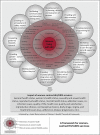Women-specific HIV/AIDS services: identifying and defining the components of holistic service delivery for women living with HIV/AIDS
- PMID: 23336725
- PMCID: PMC3545274
- DOI: 10.7448/IAS.16.1.17433
Women-specific HIV/AIDS services: identifying and defining the components of holistic service delivery for women living with HIV/AIDS
Abstract
Introduction: The increasing proportion of women living with HIV has evoked calls for tailored services that respond to women's specific needs. The objective of this investigation was to explore the concept of women-specific HIV/AIDS services to identify and define what key elements underlie this approach to care.
Methods: A comprehensive review was conducted using online databases (CSA Social Service Abstracts, OvidSP, Proquest, Psycinfo, PubMed, CINAHL), augmented with a search for grey literature. In total, 84 articles were retrieved and 30 were included for a full review. Of these 30, 15 were specific to HIV/AIDS, 11 for mental health and addictions and four stemmed from other disciplines.
Results and discussion: The review demonstrated the absence of a consensual definition of women-specific HIV/AIDS services in the literature. We distilled this concept into its defining features and 12 additional dimensions (1) creating an atmosphere of safety, respect and acceptance; (2) facilitating communication and interaction among peers; (3) involving women in the planning, delivery and evaluation of services; (4) providing self-determination opportunities; (5) providing tailored programming for women; (6) facilitating meaningful access to care through the provision of social and supportive services; (7) facilitating access to women-specific and culturally sensitive information; (8) considering family as the unit of intervention; (9) providing multidisciplinary integration and coordination of a comprehensive array of services; (10) meeting women "where they are"; (11) providing gender-, culture- and HIV-sensitive training to health and social care providers; and (12) conducting gendered HIV/AIDS research.
Conclusions: This review highlights that the concept of women-specific HIV/AIDS services is a complex and multidimensional one that has been shaped by diverse theoretical perspectives. Further research is needed to better understand this emerging concept and ultimately assess the effectiveness of women-specific services on HIV-positive women's health outcomes.
Keywords: CHIWOS; HIV; HIV/AIDS programming; gender; health services; women; women-centred care; women-specific services.
Figures


References
-
- UNAIDS. Annex 1: HIV and AIDS estimates and data, 2009 and 2001. Global Report: UNAIDS Report on the Global AIDS Epidemic 2010; Geneva: UNAIDS; 2010.
-
- Lin K, McElmurry BJ, Christiansen C. Women and HIV/AIDS in China: gender and vulnerability. Health Care Women Int. 2007;28:680–99. - PubMed
-
- Wang L, Wang N, Li D, Jia M, Gao X, Qu S, et al. The 2007 estimates for people at risk for and living with HIV in China: progress and challenges. J Acquir Immune Defic Syndr. 2009;50(4):414. - PubMed
-
- Public Health Agency of Canada. HIV/AIDS epi updates, July 2010; Ottawa: Surveillance and Risk Assessment Division, Centre for Communicable Diseases and Infection Control, Public Health Agency of Canada; 2010.
-
- UNAIDS. Global report: UNAIDS report on the global AIDS epidemic 2010; Geneva: UNAIDS; 2010.
Publication types
MeSH terms
Grants and funding
LinkOut - more resources
Full Text Sources
Other Literature Sources
Medical

